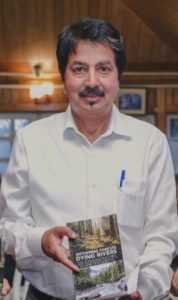Interviewed by Esha Chaudhuri
 In the recently observed World Health Day, the theme read “Our Planet, Our Health”. Leveraging on this, along with the timely release of the book ‘Weeping Forests and Dying Rivers’ conceptualised and authored by Naba Bhattacharjee, Sunday Shillong dialogues with him to delve into his championing role in the field. Excerpts from the interview are as follows –
In the recently observed World Health Day, the theme read “Our Planet, Our Health”. Leveraging on this, along with the timely release of the book ‘Weeping Forests and Dying Rivers’ conceptualised and authored by Naba Bhattacharjee, Sunday Shillong dialogues with him to delve into his championing role in the field. Excerpts from the interview are as follows –
NB: Yes, and thank you for the best wishes on the book release. Environment became an integral part of my life when I chose it as a profession and with time, it became a sort of obsession. I have enjoyed writing since my school days which later found expression in both celebrating nature and communicating not only my concerns at all round denigration of the environment, but also providing possible solutions. The book probably became a natural outcome, built on the foundation of several articles, penned on the subject for over two decades and more in platforms provided by dailies like The Shillong Times, The Telegraph and others.

‘Weeping Forests and Dying Rivers’, is a work highlighting concerns regarding the defiled status of our environment. My passion for preservation of the environment prompted showcasing of issues such as the depleting forest cover, receding catchments of water sources, rapid disappearance of hills, defilement of rivers and water bodies, mining of fossil fuels, ills of harnessing ground water and above all the urgent need to revert back to age old wisdom and traditional modes of conservation as a guiding principle. Has the situation improved or further deteriorated? It is for the readers to comprehend and decide. As for me, most of the issues remain unresolved.
SS: You’ve also played a crusading role during the peak of COVID-19 especially with bolstering vaccination. What are some of your personal learnings from that?
NB: Not crusading but humbly assisting our entire health and other frontline workers who put their lives on the line for others. COVID -19 was probably among the biggest challenges  faced by mankind – precious lives were lost, with helplessness till the vaccine was developed and emerged as the only available panacea. Yet, it was bewildering that many in our state resisted vaccination. My inner call was to reach out and make an effort to help in overcoming vaccine hesitancy through various logical interventions.
faced by mankind – precious lives were lost, with helplessness till the vaccine was developed and emerged as the only available panacea. Yet, it was bewildering that many in our state resisted vaccination. My inner call was to reach out and make an effort to help in overcoming vaccine hesitancy through various logical interventions.
From my personal experience and interaction, I learned that vaccine hesitancy is complex and context specific, varying across time, place, and vaccines. It includes factors such as complacency, convenience, and confidence. Overcoming vaccine hesitancy did not happen overnight, but working with the community to understand their fears and addressing these through providing right information, building trust and developing measurable outcomes. The challenge was to counter social media platforms and a viable strategy to overcome the phenomenon by initiating dialogues and awareness based intervention to convert resistant families into vaccination advocates.
SS: Cricket has also formed an integral part of your life. Yet, cricket and the environment are two ends of the spectrum. Would you render both as passion?
NB: Well, cricket has been a spontaneous craze since early childhood while the environment  evolved into a passion from my chosen profession. Both have converged to sustain and co-exist in my life as a motivating factor, keeping me active and agile. I have been faithful to both. I dedicated more than a decade to development of cricket in Meghalaya primarily, together with other 5 sister states of NE (except Assam and Tripura). My mission since 2008 was to obtain full membership of the Board of Control for Cricket in India (BCCI), as a permanent member, with voting rights which was finally achieved in 2017-2018. It was not easy overcoming the bias of most mainland states and I realised that a united effort of all 6 states was necessary, which was achieved with my initiative, forming the NE Cricket Development Committee, to act as a pressure group. The struggle is all documented in the proceedings of BCCI meetings. I was fortunate to be in the 7 member BCCI committee to study the Justice Lodha committee reforms which helped our NE states to achieve our goal. My next book will definitely be on cricket!
evolved into a passion from my chosen profession. Both have converged to sustain and co-exist in my life as a motivating factor, keeping me active and agile. I have been faithful to both. I dedicated more than a decade to development of cricket in Meghalaya primarily, together with other 5 sister states of NE (except Assam and Tripura). My mission since 2008 was to obtain full membership of the Board of Control for Cricket in India (BCCI), as a permanent member, with voting rights which was finally achieved in 2017-2018. It was not easy overcoming the bias of most mainland states and I realised that a united effort of all 6 states was necessary, which was achieved with my initiative, forming the NE Cricket Development Committee, to act as a pressure group. The struggle is all documented in the proceedings of BCCI meetings. I was fortunate to be in the 7 member BCCI committee to study the Justice Lodha committee reforms which helped our NE states to achieve our goal. My next book will definitely be on cricket!
NB: I come from a very humble middle-class background and a self-made man having lost my father at the age of four years; being brought up by my mother and elder brothers. My life’s journey has been like batting and negotiating the good and bad of an unpredictable cricket pitch – bouncy, uneven, fast paced, easy and even at times, turning on odd occasions, keeping low and reaching high as I bat on facing and adjusting to each ball on merit.
NB: Arunachal Pradesh has been my Karma Bhumi for over a decade and a half with baptism in my professional career as a young probationer. It is my second home where my family and I received loads of love and affection from the indigenous community, which we treasure till date. My major and most satisfying contribution was consolidating and expanding community-oriented cultivation of tea in far flung areas of the state. Today all the tea estates are established and provide livelihoods to hundreds of the local populace. When my wife, Yolanda Olivia, joined me there, she initiated teaching of young children from the villages adjoining my headquarters, which later culminated into a community managed English Medium Kindergarten School in Deomali, Tirap district. Hence, we carry fond memories of Arunachal with us.
NB: Sunderlal Bahuguna Ji. One of the main leaders of the Chipko Movement, who taught us to hug trees to protect the environment. Responding to his clarion call, men and women in the Indian Himalayas embraced and chained themselves to trees to stop loggers from cutting them down. It was a powerful message that conveyed, ‘Our bodies before our trees’. It also became a movement that brought to the world’s attention the devastation wrought by the environmental crisis in the world’s highest mountains. I had the good fortune to meet him, which was a defining moment in my life, as he spoke about the hills of Uttarakhand based on his repository of knowledge. It was like being in a place of worship with him as the presiding deity – a storehouse of traditional wisdom and approach on conservation and epitome of humility. The Chipko Movement had also become an important milestone in the fight to secure women’s rights and empowerment.
SS: What are your thoughts on Greta Thunberg? She is known for her activism, challenging many world leaders, and earns youth support and following. Do you identify with her call for climate action?
NB: Greta Thunberg is an inspiration at such a young age. She first learnt about environment issues when she was merely eight years old. I once again reiterate that all tangible change must start with self and at home. She changed her own habits, becoming a vegan and refusing air travel as both livestock and airplanes emit excessive amounts of emissions contributing to global warming. I endorse her views that all high profile climate summits and slew of protocols are mere rhetorics and thus a resounding failure, being consigned to PR exercise. I identify with her statement “We don’t just need goals for just 2030 or 2050. We, above all, need them for 2020 and every following month and year to come.”
SS: As per data, India Water Portal states that 43% of water bodies are polluted in Meghalaya. For a small state like ours, the figures are disconcerting. What comprehensive strategies would you suggest to overcome this crisis?
NB: You are correct. The situation has been alarming since the beginning of the millennium. I first raised this grave concern in 2004 which takes place in the first chapter of my book. Pollution of our rivers and water bodies was completely human induced. Dumping of solid waste, construction materials, direct discharge of sewage, acidic discharge from mining and host of similar anthropogenic factors were impinging adversely on our water bodies. There were efforts from civil society groups but were not leading anywhere in absence of deterrent action as per law. I finally decided to file a PIL with the National Green Tribunal (NGT) in 2014 highlighting in detail all causal factors for the pollution of Wahumkhrah, Umshuyrpi and Umiam with tangible solutions for rejuvenation, including responsibility of all settlement on the river banks all along their course. The various orders and directions of NGT helped to arrest the situation somewhat with penal action on violators were invoked. Civic management was geared up with better management of solid waste and waste water, sullage with Shillong city. In fact, other strategies are in place under various schemes like river rejuvenation plan. The issue lies with sincere implementation, judicious use of funds and involving the civil society and grassroot institutions of governance, associating third party audit and above all cooperation of public in sustaining all interventions.
NB: Start small – begin with self; one’s own home, then in schools, colleges and community – in that order. That’s adequate to bring in a revolution, leave aside change. Follow Thunberg. Her small campaign had a global effect, inspiring thousands of young people across the world to organise their own strikes. By December 2018, more than 20,000 students – from the UK to Japan – had joined her by skipping school to protest. In our own Shillong a humble but committed effort has been undertaken by the group Operation Clean Up (OCU) to clean Wahumkhrah – a practical initiative instead of arm chair preaching. I would appeal to all school children and other organizations mainly Dorbar Shnong, Welfare societies, defence and para military forces et al to undertake such similar missions. All schools must form a Green Brigade in the line of NCC and work towards conservation. Let us shed our inhibitions and begin in earnest. Cleaning the mind first is important.
Naba Bhattacharjee is a prominent socio-cultural activist from Shillong, who has previously worked with the Arunachal Pradesh Forest Development Corporation. He has been associated with numerous projects on forestry, renewable energy, urban development, water resources and other similar projects initiated by the Government of India, and has authored a number of publications on environment and natural resources aimed at generating public awareness on these issues. At present he is Technical Advisor to the Chief Minister of Meghalaya.



